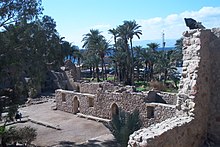Akaba (Jordan)
|
العقبة Aqaba |
||
|---|---|---|
|
|
||
| Coordinates | 29 ° 31 ' N , 35 ° 0' E | |
| Basic data | ||
| Country | Jordan | |
| Aqaba | ||
| ISO 3166-2 | JO-AQ | |
| Residents | 80,059 (2004) | |
| Culture | ||
| Twin cities |
|
|
Akaba (also Aqaba , Arabic العقبة, DMG al-ʿAqaba 'steep rise', local pronunciation el-ʿAgabe ) is a city in Jordan with 80,059 inhabitants (2004 census). It is a seaport on the Gulf of Aqaba (also Gulf of Eilat ), a branch of the Red Sea .
Akaba is the only seaport in Jordan. The main sources of income are tourism and the export of phosphate fertilizers . Akaba is also the only Jordanian dive site on the Red Sea. Under King Hussein I , part of the coral reefs were placed under nature protection and additional artificial reefs were created in the 1990s . Nevertheless, the coral reefs are still in danger.
Akaba is a free trade zone and has an airport .
history
Akaba was an important trading center even in ancient times . On the site of the present-day city there were probably two forerunner settlements mentioned in the Bible, namely Eilat and Ezjon-Geber . To the east of Aqaba, numerous rock carvings have been documented that testify to the use of the desert there between the Chalcolithic and the present.
Under the rule of the Ptolemies the place was called Berenike . Until the year 106 AD, the city belonged to the Nabataean Empire for about 250 years , but after the annexation of the empire by the Romans it was incorporated into the province of Arabia Petraea under the name Aila or Aelana and played in particular for the India trade a not insignificant role. With the division of the empire in 395, the city came under the Eastern Roman Empire .
In the course of the rise of Islam , the city was conquered during Muhammad's lifetime between 622 and 632 and then became part of the caliphate . In the early 12th century, the city was conquered by the crusaders who built Helim Castle on the nearby Pharaoh Island . Under Saladin , the city was conquered in 1170 and came under the influence of the Mamluks in 1250 . From the beginning of the 16th century until 1917 the city was part of the Ottoman Empire .
In July 1917, the strategically important city was captured by the Arab tribes of Faisal I under the command of Thomas Edward Lawrence after a forced march through the Nefud desert . The city remained under British control as part of Transjordan until 1946, when it became the largest port city in the State of Jordan . The city was occupied by Israel from November 1956 to January 1957 ( Suez Crisis ).
While in port, the USS Ashland (LSD-48) and the accompanying USS Kearsarge (LHD-3) were shot at by terrorists with three Katyushas on August 19, 2005 . One missile narrowly missed the bow of the Ashland and killed a Jordanian soldier on the quay, the other two missed the ships by a greater distance.
Attractions
Glass-bottom boats offer tours in the harbor . The flagpole is one of the tallest in the world.
Town twinning
-
 Málaga , Spain
Málaga , Spain
Climate table
| Aqaba | ||||||||||||||||||||||||||||||||||||||||||||||||
|---|---|---|---|---|---|---|---|---|---|---|---|---|---|---|---|---|---|---|---|---|---|---|---|---|---|---|---|---|---|---|---|---|---|---|---|---|---|---|---|---|---|---|---|---|---|---|---|---|
| Climate diagram | ||||||||||||||||||||||||||||||||||||||||||||||||
| ||||||||||||||||||||||||||||||||||||||||||||||||
|
Average monthly temperatures and rainfall for Aqaba
Source: WMO
|
|||||||||||||||||||||||||||||||||||||||||||||||||||||||||||||||||||||||||||||||||||||||||||||||||||||||||||||||||||||||||||||||||||
See also
literature
- Immanuel Benzinger : Berenike 4 . In: Paulys Realencyclopadie der classischen Antiquity Science (RE). Volume III, 1, Stuttgart 1897, Col. 280.
- David Heinrich von Müller : Ailana . In: Paulys Realencyclopadie der classischen Antiquity Science (RE). Volume I, 1, Stuttgart 1893, column 1008.
- Avraham Negev : Aelana or Aila (Tell el-Khuleifa) Israel . In: Richard Stillwell et al. a. (Ed.): The Princeton Encyclopedia of Classical Sites. Princeton University Press, Princeton NJ 1976, ISBN 0-691-03542-3 .
Web links
Individual evidence
- ↑ Dirk Hecht: Rock Art in the Aqaba Area . In: Orient Archeology . Volume 23 (2009), 113-126.
- ↑ Samantha L. Quigley: Rocket Attacks Miss US Navy Ships. In: navy.mil. US Navy, August 19, 2005, accessed May 18, 2014 .



